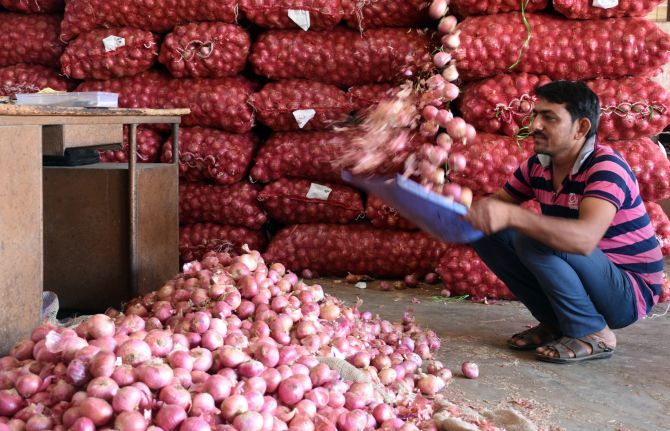Farmers and other stakeholders in the value chain estimate that 30 per cent crop damage this kharif season would result in a decline of about 2 million tonnes in output from Lasalgaon district alone.

Raghunath Sawant, an onion farmer from Niphad taluka in Maharashtra’s Nashik district, is a worried man.
And, he is not alone. Despite onion prices hitting Rs 130 a kg in the wholesale market, Sawant has not gained enough to make a profit this season.
“I have never seen such high prices in the 55 years of my life.
"But these high rates were no good for farmers like me.
"Onions produced last year and stored in warehouses went bad because of extended rainfall and flooding.
"The entire stock got spoilt, causing massive shortage.
"Floods also affected twice the seeds that were sown for this kharif season.
"We were forced to sow onion seeds for a third time.
"That increased our cost of production and also caused a six-week delay in the new crop cycle.
"By the time of new arrivals, prices had crashed nearly 50 per cent,” says Sawant.
Arjun Hingole, another Lasalgaon farmer who has three acres of land under onion, shares Sawant’s views.
“Onion farmers across the country are suffering from a double whammy - first, last year’s stock getting spoilt, and second, a sharp decline in yield,” he says.
Many farmers in Maharashtra, Gujarat, Rajasthan, Andhra Pradesh, and Karnataka have started harvesting onion before crop maturing to benefit from high prices.
But high moisture in fields has stunted onion bulbs’ growth, reducing the yield by up to 40 per cent.
Farmers and other stakeholders in the value chain estimate that 30 per cent crop damage this kharif season would result in a decline of about 2 million tonnes in output from Lasalgaon district alone.
Similar crop damage across the country could lead to an onion shortage of nearly 7 million tonnes this year.
This shortfall might need to be met through a higher acreage in states other than Maharashtra - Gujarat, Karnataka, Rajasthan, and non-traditional ones like Bihar, Uttar Pradesh and West Bengal.
What’s worse for farmers is that prices, already falling sharply, could see a further slide.
“Prices are unlikely to rise from here, as the arrival of local seasonal ‘red onion’ has started increasing.
"Farmers have also started harvesting pre-mature onion crop to benefit from high prices before a drop.
"So, prices have fallen by 42 per cent in the past two days to Rs 41 a kg in the Lasalgaon wholesale mandi.
"They will decline further to Rs 20-25 a kg over the next two weeks,” says Suvarna Jagtap, chairman of APMC Lasalgaon.
Earlier, onion prices had surged to Rs 130-140 a kg in retail markets, as sellers purchased the bulb at Rs 75-80 a kg from wholesale mandis.
APMC Lasalgaon Secretary Narendra Wadhwane says: “For any commodity, a price rise gets reflected in retail markets immediately; but a price decline comes with a lag of about a week.
"So, onion price decline in wholesale mandis should get reflected in about a week to 10 days.”
Meanwhile, in a relief to farmers, cold waves have intensified in some parts and soil moisture has started reducing.
Such a climatic condition favours standing onion crop, helping increase the size of the bulbs, and the yield thereby.
“Now, onion arrivals will increase further with the arrival of red onion from major producing centres of Maharashtra.
"With a shelf life of only two-three days, red onion needs to be sold immediately.
"So, the government must withdraw stock limit on onions,” says Jaydatta Holkar, former chairman, APMC Lasalgaon.
Interestingly, rise in onion prices is a cyclical phenomenon, occurring every three years.
In view of high prices, farmers typically increase area under the crop which leads to a sharp rise in output in the next two years.
“The government has allowed onion import at a landed cost of Rs 80 a kg. Why can the same price not be given to local farmers,” asks Pramod Purandhare, a Niphad-based farmer.
Farmers, nevertheless, are stressing the government's stable onion export policy, as this was banned until two months ago.
Photograph: ANI Photo













 © 2025
© 2025